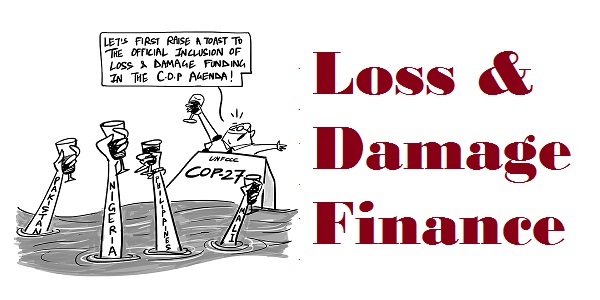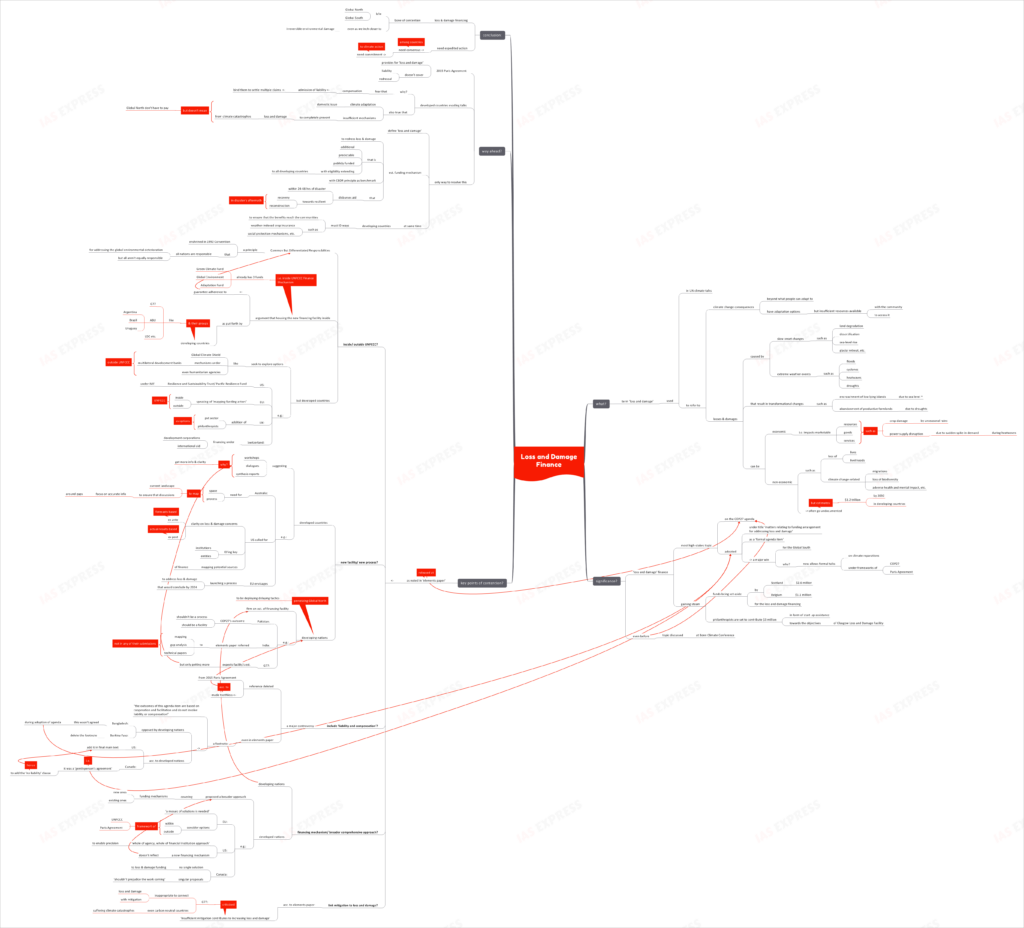Loss and Damage Finance- Key Points of Dissonance at COP27

From Current Affairs Notes for UPSC » Editorials & In-depths » This topic
IAS EXPRESS Vs UPSC Prelims 2024: 80+ questions reflected
At the ongoing COP27, a key point of focus is the ‘loss and damage’ financing. The Sharm el Sheikh talks is being keenly observed for its decision on a crucial mechanism that may very well decide the safety of the developing world’s people facing the wrath of climate catastrophe.

What is ‘loss and damage’?
- In UN climate negotiations, the term ‘loss and damage’ (though not well defined)refers to climate change consequences that
- Are beyond what people can adapt to
- Have adaptation options but the community doesn’t have sufficient resources for them
- It refers to losses and damages caused by
- Slow-onset changes, such as land degradation, desertification, sea-level rise, glacial retreat, etc.
- Extreme weather events, such as floods, cyclones, heatwaves and droughts.
- Such damages may result in transformational changes. For instance, the rising sea-level encroaches into low lying islands and droughts lead to abandonment of productive farmlands.
- The losses from such changes are economic as well as non-economic.
- Economic losses and damages are those impacting marketable resources, goods and services. Eg: crop damage caused by unseasonal rains, power supply disruption due to sudden spike in demand during heatwaves, etc.
- Non-economic losses includes the loss of lives and livelihoods, climate change-related migrations, loss of biodiversity, adverse health and mental impact, etc. These losses often go undocumented. Developing countries are expected to face climate change-related residual damages worth $1.2 trillion by 2050.
Why is it significant?
- The ‘loss and damage’ finance is the most high-stakes topic on the COP27 agenda. It has been adopted, under the title ‘matters relating to funding arrangement for addressing loss and damage’, as a ‘formal agenda item’ at the ongoing conference in Sharm el Sheikh.
- This is a major win for the Global South as it now allows formal talks on climate reparations under the COP27 and Paris Agreement frameworks.
- Already the agenda is gaining steam.
- Scotland has set aside $2.6 million and Belgium, $1.1 million, for the loss and damage financing.
- Some philanthropists are set to contribute $3 million, in the form of start-up assistance, towards the objectives of the Glasgow Loss and Damage Facility.
- Even before the COP27, the topic took spotlight at the Bonn Climate Conference.
What are the key points of dissonance?
An ‘elements paper’ was released at the COP27, even as discussions on the topic continued, listing some key points of dissonance in the talks:
Should the new financing facility be inside/ outside UNFCCC?
- The 1992 Convention enshrines the CBDR principle i.e. Common But Differentiated Responsibilities. According to this principle, all nations are responsible for addressing the global environmental deterioration but all aren’t equally responsible.
- It is argued that housing the ‘loss and damage’ facility within the UNFCCC Finance Mechanism, currently consisting of 3 funds- the Green Climate Fund, Global Environment Facility and Adaptation Fund, would guarantee adherence to the CBDR principle.
- In the ongoing talks, developing countries and their groupings like G77, Least Developed Countries, ABU (Argentina, Brazil and Uruguay), etc. have been calling for the inclusion of the new loss and damage facility under the UNFCCC framework.
- On the other hand, developed countries seek to explore options such as the Global Climate Shield, mechanisms under multilateral development banks and even humanitarian agencies- but outside the UNFCCC framework. For instance,
- The US has been putting forth the Resilience and Sustainability Trust/ Pacific Resilience Fund under IMF.The EU has been speaking of ‘mapping funding actors’ both inside and outside the Convention.UK had proposed the addition of private sector and philanthropists as possible options.
- Switzerland talked of financing under ‘development corporations or international aid’.
Should a new facility or a new process be the outcome of COP27?
- The developed nations have been suggesting workshops, dialogues and synthesis reports to collect more information. For instance,
- Australia said that there is a need for ‘a space and process to map the current landscape’ to ensure that the discussions focus on ‘accurate information around gaps’.
- The US called for
- Clarity on ex ante (based on forecasts) and ex post (based on actual results) loss and damage concerns
- Identification of key institutions and entities
- Mapping potential finance sources
- The EU envisages the launch of ‘a process to identify ways to address loss and damage’ and this process is to conclude in 2024.
- On the other hand, developing nations’ bloc, such as G77, are firm on the establishment of a new financing facility at the COP27.
- Pakistan stated that the COP27’s outcome shouldn’t be a process, but a facility.
- India highlighted how the elements paper referred to mapping, gap analysis and technical papers which didn’t stem from any of their submissions.
- The G77 states that it expects the COP27 to establish funding arrangement, but is only getting more dialogues, workshops and synthesis reports.
- The Global South are perceiving the Global North to be deploying delaying tactics rather than committing to the CBDR principle.
Should ‘liability and compensation’ be included in the text?
- The reference to ‘liability and compensation’ is a major controversy in the climate talks. Notably, references to this were deleted from the 2015 Paris Agreement, rendering it toothless (according to the developing nations).
- Even in the COP27 elements paper, a footnote stated that “the outcomes of this agenda item are based on cooperation and facilitation and do not involve liability or compensation”.
- Developing countries have been opposing this footnote:
- Bangladesh held that this understanding wasn’t agreed upon when the agenda item was originally adopted.
- Burkina Faso called for the deletion of this footnote.
- On the other hand, developed nations have a different view of this footnote:
- US argued that the content of the footnote should be added to the final main text.
- Canada held that it is was a ‘gentleperson’s agreement’ during the adoption of the agenda item to add the ‘no liability’ clause and hence, this should feature in the final text.
Should the countries go for a financing mechanism or a ‘broader comprehensive approach’?
- The developing nations and the small island nations are firm on the establishment of a solid financing mechanism.
- However, developed nations have proposed a broader approach to cover both existing funding arrangements, as well as, new mechanisms.
- According to the EU, ‘a mosaic of solutions is needed’ and the countries need to consider options within and outside the frameworks of UNFCCC and the 2015 Agreement.
- The US suggested a ‘whole of agency, whole of financial institution approach’, rather than a single new fund, to enable precision. It also said that a new financing mechanism ‘doesn’t reflect the broader comprehensive approach’.
- According to Canada, there isn’t a single solution to loss and damage funding, hence, singular proposals ‘shouldn’t prejudice the work coming’.
Should mitigation be linked to loss and damage?
- The COP27 elements paper suggested that ‘insufficient mitigation contributes to increasing loss and damage’.
- In response to this, the G77 said that it is inappropriate to connect loss and damage to mitigation. For instance, some countries are carbon neutral but still suffer climate catastrophes.
What is the way ahead?
- The 2015 Paris Agreement provides for ‘loss and damage’ but doesn’t cover liability and redressal.
- Developed countries have been evading negotiation on the subject as they fear that compensation would imply an admission of liability. They fear that such an admission would bind them to settle multiple claims from the Global South.
- Also, it is true that climate adaptation is a domestic issue and there aren’t any mechanisms to completely prevent loss and damage from climate catastrophes.
- However, this doesn’t mean that the Global North needn’t pay for their historical emissions that are now, disproportionately affecting the Global South. The only way to resolve this is by setting clear definition for ‘loss and damage’ and then setting up a mechanism for funding their redressal.
- The COP27 talks must focus on a new financing mechanism that is additional, grant-based, predictable, publicly funded and with eligibility covering all developing countries. The CBDR principle must serve as the benchmark for any such mechanism.
- This fund must disburse aid for loss and damage in an expedited manner i.e. within 24-48 hours of a disaster striking.
- The loss and damage financing mechanism must focus on resilient recovery and reconstruction in the disaster’s aftermath, i.e. it must aid building back better.
- At the same time, the developing countries’ governments must identify concrete ways by which the funds’ benefits reach the community, such as weather-indexed crop insurance, social protection mechanisms, etc.
Conclusion:
Loss and damage financing remains a bone of contention between the Global North and South, even as the world inches increasingly closer to an irreversibly damaged environment. Expedited action is more crucial than ever. This is possible only if the nations were to arrive at a consensus which needs the countries to commit to climate action and not evade responsibility.
Practice Question for Mains:
Discuss the debate around ‘loss and damage’ financing. What is the way ahead? (250 words)
If you like this post, please share your feedback in the comments section below so that we will upload more posts like this.

